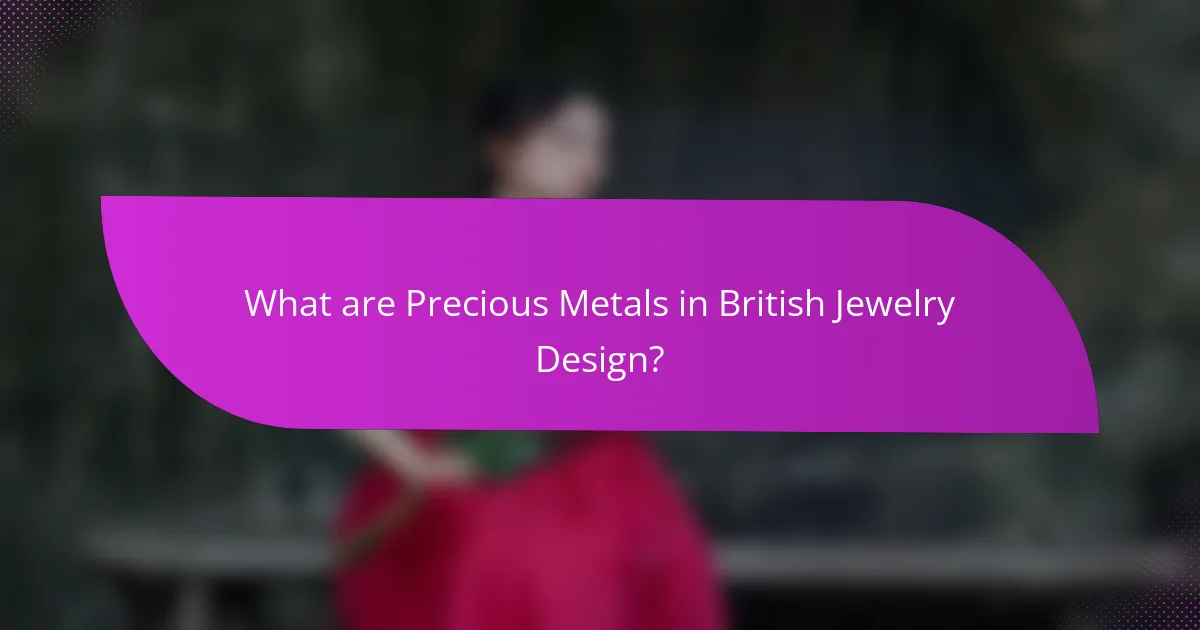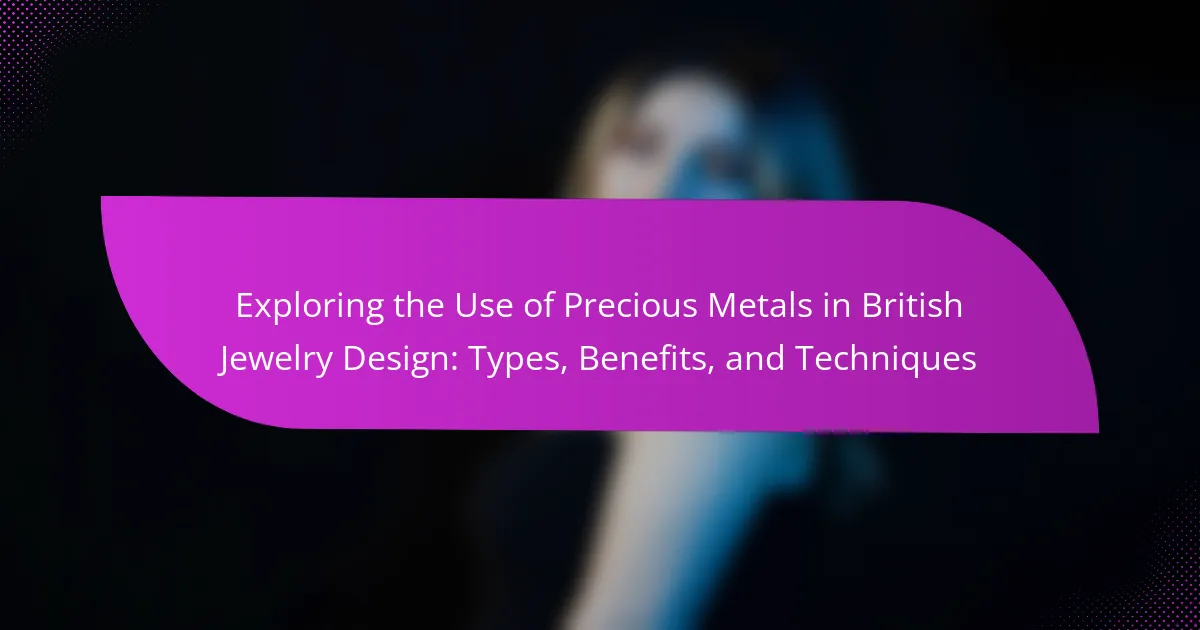This article explores the use of precious metals, specifically gold, silver, and platinum, in British jewelry design. These metals are valued for their rarity, aesthetic appeal, and historical significance, with gold and silver being prominent in royal adornments. The article outlines the benefits of using precious metals, including durability, hypoallergenic properties, and investment potential. It also covers various techniques employed in jewelry making, such as casting, forging, and soldering, which enhance the artistry and functionality of jewelry pieces. Additionally, the British hallmarking system, which ensures the authenticity and quality of these metals, is discussed, highlighting the long-standing tradition of craftsmanship in British jewelry.

What are Precious Metals in British Jewelry Design?
Precious metals in British jewelry design primarily refer to gold, silver, and platinum. These metals are valued for their rarity and aesthetic appeal. Gold is often used in various karats, with 18k being popular for its balance of purity and durability. Silver, particularly sterling silver, is widely favored for its bright luster and affordability. Platinum is prized for its strength and hypoallergenic properties. The historical significance of these metals in British jewelry dates back centuries, with gold and silver being used in royal adornments. The British hallmarking system ensures the authenticity and quality of precious metals. This system dates back to the 14th century, reflecting the long-standing tradition of craftsmanship in British jewelry design.
Why are precious metals important in jewelry design?
Precious metals are important in jewelry design due to their aesthetic appeal and durability. They provide a luxurious look that enhances the overall design of jewelry pieces. Gold, silver, and platinum are the most commonly used precious metals. These metals resist tarnishing and corrosion, ensuring longevity. Precious metals also have significant value, making them desirable for investment. Their malleability allows for intricate designs and detailed craftsmanship. Historically, precious metals have been associated with wealth and status, adding cultural significance to jewelry. Their rarity contributes to their allure, making them a preferred choice for fine jewelry.
What distinguishes precious metals from other materials used in jewelry?
Precious metals are distinguished from other materials used in jewelry by their rarity, intrinsic value, and resistance to tarnish. Precious metals, such as gold, silver, and platinum, are valued for their limited availability in nature. This rarity contributes to their higher market prices compared to common materials like copper or aluminum. Additionally, precious metals possess a unique ability to resist corrosion and tarnish, ensuring longevity and maintaining aesthetic appeal. For instance, gold does not oxidize, allowing it to retain its luster over time. In contrast, many other materials require regular maintenance to prevent degradation. The historical significance of precious metals also sets them apart, as they have been used for centuries in various cultures for jewelry and currency. This cultural heritage further enhances their desirability in jewelry design.
How do precious metals contribute to the overall value of jewelry?
Precious metals significantly enhance the overall value of jewelry. Their rarity and intrinsic value contribute to the price. Gold, silver, and platinum are the primary precious metals used. Gold’s value is determined by its karat weight and market price. Silver is valued for its conductivity and luster, while platinum is prized for its durability and rarity. The craftsmanship and design also affect the value. Jewelry made from these metals often appreciates over time. Historical significance can further increase value, as seen in antique pieces.
What types of precious metals are commonly used in British jewelry design?
Gold, silver, and platinum are commonly used precious metals in British jewelry design. Gold is favored for its malleability and luster. It is available in various karats, with 9K, 14K, and 18K being popular choices. Silver is appreciated for its affordability and brightness. Sterling silver, which contains 92.5% silver, is a standard in jewelry making. Platinum is valued for its durability and rarity. It is often used in high-end pieces due to its strength and hypoallergenic properties. These metals have a long history in British jewelry, reflecting cultural significance and craftsmanship.
What are the characteristics of gold as a precious metal in jewelry?
Gold is a highly valued precious metal in jewelry due to its unique characteristics. It is malleable, allowing it to be shaped into intricate designs. Gold does not tarnish or corrode, ensuring longevity in jewelry pieces. Its natural luster gives a warm, appealing appearance. Gold is available in various karatages, indicating its purity level. Higher karat gold contains more gold content, enhancing its value. Additionally, gold can be alloyed with other metals to create different colors, such as white or rose gold. The historical significance of gold in jewelry dates back thousands of years, reinforcing its status as a timeless choice.
How does silver differ from gold in terms of usage and value?
Silver is primarily used in jewelry, electronics, and photography, while gold is mainly valued for investment and luxury items. Silver has a lower market value, averaging around $25 per ounce, compared to gold’s value of approximately $1,900 per ounce. The industrial demand for silver is significant, especially in technology and renewable energy sectors. Gold, on the other hand, is often viewed as a safe-haven asset during economic uncertainty. Silver’s properties make it highly conductive, ideal for electrical applications. Gold’s rarity and historical significance contribute to its status as a symbol of wealth. The differing applications and values of these metals reflect their unique attributes and market perceptions.
What role does platinum play in British jewelry design?
Platinum plays a significant role in British jewelry design due to its durability and luster. It is highly resistant to tarnish and corrosion, making it ideal for everyday wear. British jewelers often choose platinum for engagement rings and wedding bands because of its strength and ability to hold gemstones securely. Platinum’s rarity adds to its appeal, positioning it as a luxury choice in the market. The metal’s natural white hue complements various gemstones, enhancing their brilliance. In historical contexts, platinum gained popularity in the early 20th century, particularly during the Art Deco period. British designers have embraced platinum for its versatility in both contemporary and traditional styles. This metal remains a symbol of elegance and quality in British jewelry.

What are the Benefits of Using Precious Metals in Jewelry?
Precious metals in jewelry offer several benefits. They provide durability, ensuring pieces last over time. Gold, silver, and platinum resist tarnishing and corrosion. These metals also have hypoallergenic properties, making them suitable for sensitive skin. Precious metals can enhance the aesthetic appeal of jewelry with their luster and shine. They often hold intrinsic value, contributing to the piece’s investment potential. Furthermore, precious metals are malleable, allowing for intricate designs and craftsmanship. Their historical significance adds cultural value to jewelry pieces. Overall, using precious metals elevates the quality and desirability of jewelry.
How do precious metals enhance the aesthetic appeal of jewelry?
Precious metals enhance the aesthetic appeal of jewelry by providing a luxurious and timeless appearance. Their natural luster and shine attract attention and evoke a sense of elegance. Gold, silver, and platinum are often used for their unique colors and finishes. For example, yellow gold offers warmth, while white gold provides a modern look.
The malleability of precious metals allows for intricate designs and detailed craftsmanship. This enables jewelers to create unique shapes and settings that highlight gemstones. Additionally, the durability of these metals ensures that jewelry maintains its beauty over time.
Historical significance also plays a role in their appeal. Precious metals have been valued for centuries, symbolizing wealth and status. This cultural context adds to their desirability in contemporary jewelry.
What unique qualities do precious metals bring to design elements?
Precious metals bring distinctive qualities to design elements, including durability, malleability, and aesthetic appeal. Their durability ensures longevity, making them ideal for jewelry that withstands daily wear. Malleability allows for intricate designs, enabling jewelers to create detailed and unique pieces. Additionally, precious metals like gold and silver have a natural luster that enhances visual attractiveness. This luster contributes to the overall elegance of jewelry designs. Furthermore, precious metals can be alloyed with other metals, providing versatility in color and strength. The historical significance of precious metals also adds value to jewelry, as they are often associated with luxury and status.
How do precious metals influence consumer perception of jewelry?
Precious metals significantly enhance consumer perception of jewelry. Their rarity and intrinsic value create a sense of luxury. Consumers associate precious metals with quality and durability. For instance, gold and platinum are often seen as symbols of wealth. This perception drives higher demand for jewelry made from these materials. According to a 2021 survey by the Jewelry Consumer Opinion Council, 78% of consumers prefer jewelry made from precious metals. This preference reflects a desire for investment and status. Additionally, the craftsmanship associated with precious metals further elevates consumer expectations. Overall, precious metals shape how consumers view the value and appeal of jewelry.
What are the practical benefits of using precious metals?
Precious metals offer several practical benefits, particularly in jewelry design. They are durable and resistant to tarnish, ensuring longevity. Gold, silver, and platinum maintain their luster over time. Precious metals also possess hypoallergenic properties, making them suitable for sensitive skin. Their intrinsic value provides a hedge against inflation and economic instability. Additionally, precious metals can be easily recycled, promoting sustainability. The aesthetic appeal of these metals enhances the visual quality of jewelry. Their rarity contributes to their desirability and market value.
How do precious metals affect the durability of jewelry pieces?
Precious metals significantly enhance the durability of jewelry pieces. Metals like gold, platinum, and silver resist tarnishing and corrosion. Gold, especially in higher karats, is less prone to scratching. Platinum is denser and more durable than gold, making it ideal for settings. Silver, while softer, can be alloyed to improve strength. The alloying process creates a more resilient material, extending the lifespan of jewelry. Historical evidence shows that ancient civilizations valued gold for its longevity. Jewelry made from precious metals can last generations with proper care.
What is the significance of precious metals in terms of resale value?
Precious metals hold significant resale value due to their intrinsic worth and market demand. Gold, silver, and platinum are widely recognized for their ability to retain value over time. The global market prices for these metals fluctuate but generally trend upwards, making them a stable investment. For instance, gold has historically maintained its value, often used as a hedge against inflation. According to the World Gold Council, gold prices have increased by over 300% in the past two decades. This trend supports the notion that precious metals can be a reliable asset for resale. Additionally, the rarity of certain precious metals can further enhance their resale potential. Collectors and investors often seek these metals, driving up their market value. This demand ensures that precious metals remain a valuable commodity in the resale market.

What Techniques are Employed in Working with Precious Metals?
Techniques employed in working with precious metals include casting, forging, and soldering. Casting involves pouring molten metal into a mold to create specific shapes. This method allows for intricate designs and is widely used in jewelry making. Forging is the process of shaping metal through hammering or pressing. It enhances the metal’s strength and creates a unique texture. Soldering joins two metal pieces using a filler metal that melts at a lower temperature. This technique is essential for assembling components in jewelry. Other techniques include engraving, which adds decorative designs, and polishing, which enhances the metal’s shine. Each technique contributes to the artistry and functionality of precious metal jewelry.
What are the common techniques used in crafting jewelry from precious metals?
Common techniques used in crafting jewelry from precious metals include casting, forging, and soldering. Casting involves pouring molten metal into a mold to create a specific shape. This technique allows for intricate designs and is often used for unique pieces. Forging involves shaping metal through hammering or pressing, resulting in a strong and durable item. Soldering is the process of joining two pieces of metal together using a filler material that melts at a lower temperature. Other techniques include engraving, which adds decorative details, and stone setting, where gemstones are secured into the metal. Each technique contributes to the overall design and functionality of the jewelry.
How does the process of casting work in jewelry design?
Casting in jewelry design involves creating a mold and pouring molten metal into it. The process begins with sculpting a model of the desired piece, often using wax or clay. This model is then encased in a material that hardens to form a mold. Once the mold is ready, it is heated to remove the model, leaving a cavity in the shape of the jewelry piece.
Next, molten metal is poured into the mold cavity. The metal can be gold, silver, or other precious alloys. After the metal cools and solidifies, the mold is broken away to reveal the cast jewelry. This method allows for intricate designs that are difficult to achieve through other techniques.
Casting has been a fundamental technique in jewelry making for centuries, dating back to ancient civilizations. It enables mass production of jewelry pieces while maintaining high detail.
What is the significance of soldering in creating jewelry pieces?
Soldering is crucial in jewelry making as it permanently joins metal components. This technique allows artisans to create intricate designs and secure gemstones effectively. Soldering provides structural integrity, ensuring that pieces withstand wear and tear. Historical evidence shows that soldering has been used since ancient times, highlighting its importance in craftsmanship. The process involves heating a filler metal to bond two pieces, resulting in a seamless finish. This method enhances the aesthetic appeal of jewelry by allowing for complex shapes and settings. Additionally, soldering enables the use of various metal types together, expanding design possibilities. Overall, soldering is a foundational technique that elevates the quality and creativity of jewelry pieces.
How do artisans incorporate precious metals into modern designs?
Artisans incorporate precious metals into modern designs through various techniques. They utilize methods such as casting, forging, and soldering to shape metals like gold, silver, and platinum. These techniques allow for intricate details and unique forms in jewelry pieces. Additionally, artisans often combine precious metals with other materials, enhancing visual contrast and appeal. For instance, gold may be paired with gemstones or ceramics to create striking designs. Artisans also experiment with finishes, such as matte or polished surfaces, to add depth and texture. The use of precious metals in modern designs reflects both traditional craftsmanship and contemporary aesthetics. This blend appeals to today’s consumers who value both artistry and quality.
What innovative techniques are being used in contemporary British jewelry?
Contemporary British jewelry employs innovative techniques such as 3D printing, laser cutting, and mixed materials. 3D printing allows for intricate designs that are difficult to achieve by traditional methods. Laser cutting offers precision and the ability to create complex patterns. Mixed materials, including combining metals with textiles or ceramics, enhance the aesthetic and tactile qualities of jewelry. Techniques like electroforming enable the creation of lightweight structures while maintaining strength. Additionally, the use of sustainable practices, such as recycled metals, is gaining traction. These methods reflect a modern approach to craftsmanship and design in the British jewelry scene.
How do traditional methods still play a role in modern jewelry making?
Traditional methods play a significant role in modern jewelry making by preserving craftsmanship and cultural heritage. Techniques such as hand engraving, stone setting, and metalworking are still widely used today. These methods allow artisans to create unique, bespoke pieces that reflect individual style. The use of traditional tools, like the jeweler’s saw and files, ensures precision and quality. Historical techniques provide a foundation for innovation in design and materials. Many contemporary jewelers incorporate these methods to enhance the value and authenticity of their pieces. This blend of old and new fosters a deeper connection to the art of jewelry making. Traditional methods also appeal to consumers seeking authenticity and sustainability in their purchases.
What tips can help in selecting and caring for precious metal jewelry?
When selecting and caring for precious metal jewelry, prioritize quality and maintenance. Choose pieces made from reputable sources to ensure authenticity. Look for hallmarks that indicate the metal’s purity, such as 925 for sterling silver or 750 for 18K gold. Store jewelry in a dry, cool place to prevent tarnishing. Clean pieces regularly with a soft cloth to remove dirt and oils. Avoid exposing jewelry to harsh chemicals, as they can damage the metal. For intricate designs, consider professional cleaning to maintain appearance. Following these tips helps preserve the beauty and longevity of precious metal jewelry.
The main entity of the article is precious metals in British jewelry design, specifically focusing on gold, silver, and platinum. The article explores the types of precious metals used, highlighting their attributes such as durability, aesthetic appeal, and historical significance. It discusses the importance of these metals in enhancing the overall value of jewelry, their unique qualities compared to other materials, and the techniques employed in jewelry making, including casting and soldering. Additionally, the article provides practical tips for selecting and caring for precious metal jewelry, ensuring longevity and maintaining its beauty.
